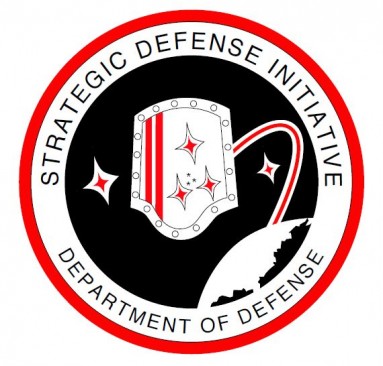High Frontier
last updated: February 27, 2017
Please note: The Militarist Monitor neither represents nor endorses any of the individuals or groups profiled on this site.

CONTACT INFORMATION
High Frontier
500 N. Washington Street
Alexandria, VA 22314
Phone: 703-535-8774
E-mail: info@highfrontier.org
Website: www.highfrontier.org
FOUNDED
1981
ABOUT
“High Frontier is the nation’s leading non-government authority on missile defense issues including missile defense, arms control, nuclear weapons, and strategic systems. Through our publications, research, congressional testimony and nationwide network of volunteers and supporters we provide a powerful voice that actively supports the deployment of an effective defense againstballistic missiles.”
High Frontier, founded in 1981, is a small pressure group that promotes extravagant missile defense programs, including the Strategic Defense Initiative (SDI), or “Star Wars,” launched under President Ronald Reagan. Though initially focused on building a national missile defense system, High Frontier’s scope expanded to regional theaters in Asia, Middle East, and Europe, as part of a global defense system.[1] High Frontier has also sponsored a project titled “Jamestown on the Moon,” with the aim of ensuring that future moon settlements would bear “the flag of Freedom and Enterprise.”[2]
According to Edwin J. Feulner, founder of the Heritage Foundation, High Frontier got its start when Joseph Coors “joined a small group assembled by [Hydrogen Bomb inventor Edward] Teller that called itself High Frontier.”[3] The Heritage Foundation funded the first study that High Frontier published on missile defense.[4]
Lieutenant General Daniel O. Graham, the organization’s founder, was a military affairs adviser to Reagan during his 1976 and 1980 presidential campaigns. He was also a high intelligence official, serving as CIA Deputy Director (1973-74) and then director of the Defense Intelligence Agency (1974-76). Even when working within the intelligence apparatus, Graham was a harsh critic of the CIA’s intelligence estimates, which he accused of underestimating Soviet military capacity and imperial ambitions.[5] Although discredited by impartial observers, this view was widely shared among neoconservatives and other hawkish policy ideologues, eventually leading to the establishment of the controversial Team B initiative in the late 1970s.
As an early supporter of the flexible deterrence and nuclear weapons strategies proposed by RAND’s Albert Wohlstetter, Graham believed that U.S. intelligence estimates about the purported Soviet threat should be driven by the assumption that the Soviet Union intended to defeat the United States.[6]
The chairman of High Frontier’s board is Henry Cooper, the former director of George H.W. Bush’s Strategic Defense Initiative Organization (SDIO).[7] Cooper was the chief negotiator for Reagan during the Geneva Defense and Space Talks, where he advocated for SDI programs.[8] He held a number of other positions during Reagan’s tenure, including assistant director of the Arms Control and Disarmament Agency and deputy assistant secretary of the Air Force. Cooper also conducted an independent review of SDI programs for then-Defense Secretary Dick Cheney during the George H.W. Bush administration.[9]
In 2001, Cooper led the charge to reinvigorate the Star Wars programs, successfully lobbying former president George W. Bush to desert the Anti-Ballistic Missile Treaty.[10] That same year he addressed the “Defending the Northeast, America and Our Allies from Ballistic Missile Attack” conference sponsored by former Rep. Curt Weldon (R-PA) and the Institute for Foreign Policy Analysis. Of the 200 participants, at least 70 represented the top defense contractors: Raytheon, Boeing, and Lockheed Martin.[11]
Cooper is chairman emeritus of Applied Research Associates, Inc., whose defense services include “assessing the potential effects of weapons against critical national defense systems.”[12] Cooper has also served as a member of the Center for Security Policy’s National Security Advisory Council, labeled by Michelle Ciarrocca and William Hartung of the Arms Trade Resource Center as the “Star Wars Hall of Fame.”[13]
High Frontier and other proponents of missile defense systems contend that the 9/11 attacks underscore the need for a global missile defense shield, despite the fact that Star Wars systems have yet to be proven technically feasible and is not intended to defend against the type of attack perpetrated on the 9/11.[14]
High Frontier has received significant funding from organizations such as the Carthage Foundation, the John M. Olin Foundation, and the Sarah Scaife Foundation.
